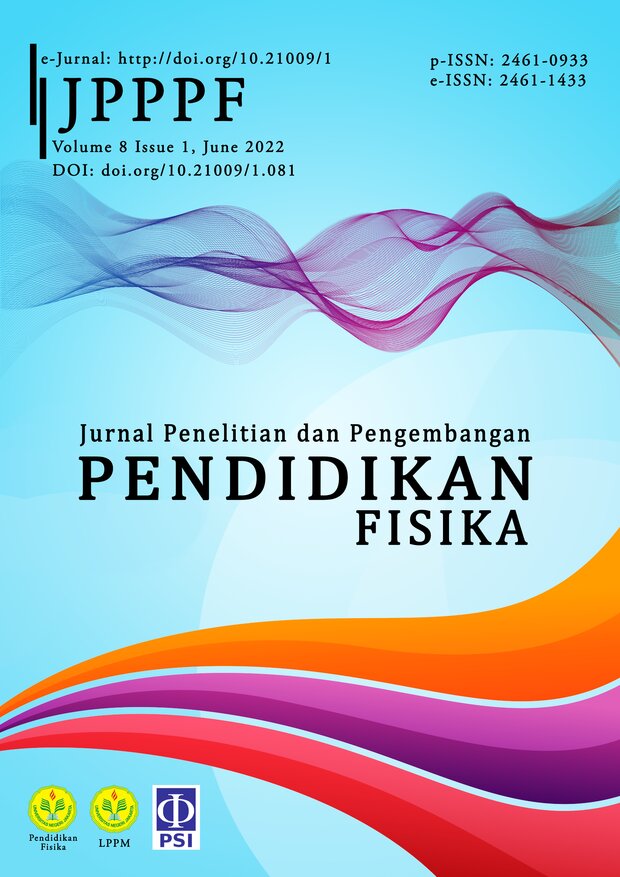The Development of Educational Aids for Restitution Coefficient Experiment Using Microcontroller
DOI:
https://doi.org/10.21009/1.08109Keywords:
educational aids, microcontroller, worksheets, coefficient of restitutionAbstract
This study aims to produce a product in the form of high school physics teaching aids for collision materials. The aids developed consist of Arduino as the central controller, photodiode sensor, and infrared sensor as ball motion detector mounted on the side of the tube track as high as 100 cm. The aids can record the time and altitude automatically on the bouncing ball. The research method used is R&D development research with the ADDIE model, which includes five stages, analysis, design, development, implementation, and evaluation. The variables used are variations in the type of ball and the pedestal type. Three types of balls are used: ping pong, golf, and tennis. The base types are ceramic floor, stainless steel, and acrylic. The ball bounce is an elastic collision partly because it has a restitution coefficient value of 0 < e < 1. This experiment is done by ignoring air resistance and tracking friction. Students can make observations with the help of worksheets, which were also developed into the one-unit package. Through the validation test phase, the product has the worksheets get a value of 91% and the teaching aids 81%, which means that the worksheets and teaching aids are suitable for teaching materials to support learning physics.
References
Arief, IS & Adjie, RW 2019, ‘Developing Experimental of Dimple Effect Applied on Flat Plate against Fluid Flow’, International Journal of Marine Engineering Innovation and Research, vol. 4, pp. 69-77.
Clough, M 2007, ‘Learning and teaching in the school science laboratory: An analysis of research, theory and practice’, In book: Handbook of Research on Science Education, Lawrence Erlbaum Associates.
Indrasari W, Rustana, CE & Zulfikar, Z 2021, ‘Development a practicum tools to measure the speed of the air using Arduino Uno Microcontroller’, Journal of Physics: Conference Series, vol. 1816, p. 012109.
Indrasari, W, Budi, A & Fadilla, D 2021, ‘Development of a set of aids for collision based on Arduino Uno Microcontroller’, Journal of Physics: Conference Series, vol. 1816, p. 012107.
Indrasari, W, Budi, AS & Fadilla, DP 2020, ‘Rancang Bangun Alat Peraga Tumbukan Berbasis Mikrokontroller Untuk SMA’, Prosiding Seminar Nasional Fisika (E-JOURNAL), vol. 9, SNF2020PF-91.
Indrasari, W, Rustana, CE, Arifin, F & Muliyati, D 2021, ‘Development of beat frequency practicum device using Arduino UNO and AD9833 module’, AIP Conference Proceedings, vol. 2320, p. 050041.
Lehavi Y, Mualem R, Bagno E, Eylon BS & Pospiech G 2019, ‘Taking the Phys-Math Interplay from Research into Practice’, Mathematics in Physics Education, pp. 335-353.
Nawi, A, Hamzah, M, Ren, C & Tamuri, AH 2015, ‘Adoption of Mobile Technology for Teaching Preparation in Improving Teaching Quality of Teachers’, International Journal of Instruction, vol. 8, pp. 113-124.
Ng, TS 2016, ‘Microcontroller’, Real Time Control Engineering, Studies in Systems, Decision and Control, vol. 65, pp. 39-77.
Pattar, U & Joshi, AW 2002, ‘Head-on collision of two balls revisited’, Reson, vol. 7, pp. 67-77.
Permana, H et al. 2021, ‘The Development of Augmented Reality Application to Explore Fluid Concepts’, Jurnal Penelitian & Pengembangan Pendidikan Fisika, vol. 7, pp. 53-60.
Purahong, B 2013, ‘Learning the basics of microcontroller starter kit boards AVR (eSnack)’, Proceedings of 2013 IEEE International Conference on Teaching, Assessment and Learning for Engineering (TALE), pp. 29-32.
Putri, SE & Suwarna, IP 2020, ‘The Experimental Study of Kinesthetic Style Student Learning Outcomes in Remedial Teaching Assisted by Projectile Motion Props’, Jurnal Penelitian & Pengembangan Pendidikan Fisika, vol. 6, pp. 25-36.
Redish, EF & Kuo, E 2015, ‘Language of Physics, Language of Math: Disciplinary Culture and Dynamic Epistemology’, Sci & Educ, vol. 24, pp. 561-590.
Ribeiro, T, Romero, J, Andrade-Romero, JA 2012, ‘Novel Techniches for Experimental Determination of The Restitution Coefficient by Means of Acoustic Signal Analysis’, ABCM Symposium Series in Mechatronics, vol. 5, pp. 676-683.
Saepuzaman, D & Yustiandi, Y 2017, ‘Pengembangan Alat Peraga dan Lembar Kerja Percobaan Penentuan Koefisien Restitusi untuk Meningkatkan Kemampuan Siswa Bereksperimen’, Jurnal Penelitian & Pengembangan Pendidikan Fisika, vol. 3, pp. 145-150.
Shen, F, Wang, Y, Shen, C et al. 2017, ‘On the Collision Nature of Two Coronal Mass Ejections’, A Review. Sol Phys, vol. 292, 104.
Wu, Z, Qiu, K & Zhang, J 2020, ‘A Smart Microcontroller Architecture for the Internet of Things’, Sensors, vol. 20, p. 1821.
Yang, J, Silvestro, C, Khatri, D, De Nardo, L & Daraio, C 2011, ‘Interaction of highly nonlinear solitary waves with linear elastic media’, Physical review. E, Statistical, nonlinear, and soft matter physics, vol. 83, p. 046606.











